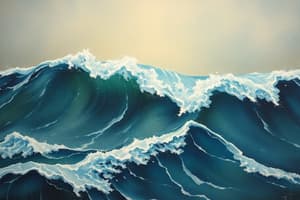Podcast
Questions and Answers
What is the normal in the context of reflection?
What is the normal in the context of reflection?
The normal is an imaginary line perpendicular to the surface at the point of incidence.
Describe the characteristics of an optical image formed by a plane mirror.
Describe the characteristics of an optical image formed by a plane mirror.
The image is virtual, upright, laterally inverted, and the same size as the object.
What relationship holds true regarding the angles of incidence and reflection?
What relationship holds true regarding the angles of incidence and reflection?
The angle of incidence is equal to the angle of reflection.
How does light behave when it passes from a less dense to a more dense medium?
How does light behave when it passes from a less dense to a more dense medium?
Define critical angle in optics.
Define critical angle in optics.
What is total internal reflection?
What is total internal reflection?
What is amplitude and what is its SI unit?
What is amplitude and what is its SI unit?
What happens to light rays when they pass through a converging lens?
What happens to light rays when they pass through a converging lens?
How is wavelength defined and what is the unit used to measure it?
How is wavelength defined and what is the unit used to measure it?
How does a diverging lens affect parallel rays of light?
How does a diverging lens affect parallel rays of light?
Define frequency and provide its SI unit.
Define frequency and provide its SI unit.
What is the significance of the refractive index?
What is the significance of the refractive index?
State the equation for calculating the speed of a wave.
State the equation for calculating the speed of a wave.
What distinguishes transverse waves from longitudinal waves?
What distinguishes transverse waves from longitudinal waves?
What occurs during the dispersion of light in a prism?
What occurs during the dispersion of light in a prism?
List the traditional colors of the visible spectrum in order from longest to shortest wavelength.
List the traditional colors of the visible spectrum in order from longest to shortest wavelength.
Explain the phenomenon of refraction in waves.
Explain the phenomenon of refraction in waves.
What happens to a wave's speed and wavelength when moving from deep to shallow water?
What happens to a wave's speed and wavelength when moving from deep to shallow water?
What does Snell’s Law describe?
What does Snell’s Law describe?
What is an optical fiber's primary function?
What is an optical fiber's primary function?
Describe the process of diffraction in waves.
Describe the process of diffraction in waves.
What are the harmful effects of excessive microwave exposure on the human body?
What are the harmful effects of excessive microwave exposure on the human body?
How does infrared radiation affect human skin?
How does infrared radiation affect human skin?
What are the potential risks of ultraviolet radiation exposure?
What are the potential risks of ultraviolet radiation exposure?
Describe the dangers associated with X-rays and gamma rays.
Describe the dangers associated with X-rays and gamma rays.
What is the speed of electromagnetic waves in a vacuum?
What is the speed of electromagnetic waves in a vacuum?
Why are microwaves preferred for communication with artificial satellites?
Why are microwaves preferred for communication with artificial satellites?
What type of waves do Bluetooth devices use for communication?
What type of waves do Bluetooth devices use for communication?
How does digital signaling enhance communication compared to analogue signaling?
How does digital signaling enhance communication compared to analogue signaling?
What is the nature of sound waves?
What is the nature of sound waves?
Explain how frequency and amplitude influence sound.
Explain how frequency and amplitude influence sound.
What is the frequency range audible to humans?
What is the frequency range audible to humans?
How is an echo produced?
How is an echo produced?
Why does the speed of sound vary in different media?
Why does the speed of sound vary in different media?
What are the applications of ultrasound?
What are the applications of ultrasound?
Flashcards
Amplitude (A)
Amplitude (A)
The maximum displacement of a wave from its rest position.
Wavelength (λ)
Wavelength (λ)
The distance between two consecutive points on a wave that are in phase.
Period (T)
Period (T)
The time it takes for one complete cycle of a wave.
Frequency (f)
Frequency (f)
Signup and view all the flashcards
Transverse Wave
Transverse Wave
Signup and view all the flashcards
Longitudinal Wave
Longitudinal Wave
Signup and view all the flashcards
Refraction
Refraction
Signup and view all the flashcards
Diffraction
Diffraction
Signup and view all the flashcards
Normal (to a surface)
Normal (to a surface)
Signup and view all the flashcards
Angle of Incidence (i)
Angle of Incidence (i)
Signup and view all the flashcards
Angle of Reflection (r)
Angle of Reflection (r)
Signup and view all the flashcards
Virtual Image (plane mirror)
Virtual Image (plane mirror)
Signup and view all the flashcards
Image Size (plane mirror)
Image Size (plane mirror)
Signup and view all the flashcards
Image Distance (plane mirror)
Image Distance (plane mirror)
Signup and view all the flashcards
Lateral Inversion (plane mirror)
Lateral Inversion (plane mirror)
Signup and view all the flashcards
Angle of Incidence (refraction)
Angle of Incidence (refraction)
Signup and view all the flashcards
Angle of Refraction (r)
Angle of Refraction (r)
Signup and view all the flashcards
Refractive Index (n)
Refractive Index (n)
Signup and view all the flashcards
Critical Angle
Critical Angle
Signup and view all the flashcards
Total Internal Reflection
Total Internal Reflection
Signup and view all the flashcards
Optical Fiber
Optical Fiber
Signup and view all the flashcards
Converging Lens
Converging Lens
Signup and view all the flashcards
Diverging Lens
Diverging Lens
Signup and view all the flashcards
Sound waves
Sound waves
Signup and view all the flashcards
Pitch
Pitch
Signup and view all the flashcards
Loudness
Loudness
Signup and view all the flashcards
Echo
Echo
Signup and view all the flashcards
Compression
Compression
Signup and view all the flashcards
Rarefaction
Rarefaction
Signup and view all the flashcards
Ultrasound
Ultrasound
Signup and view all the flashcards
Speed of sound
Speed of sound
Signup and view all the flashcards
Medical scanning (using ultrasound)
Medical scanning (using ultrasound)
Signup and view all the flashcards
Non-destructive testing (using ultrasound)
Non-destructive testing (using ultrasound)
Signup and view all the flashcards
Sonar (using ultrasound)
Sonar (using ultrasound)
Signup and view all the flashcards
Electromagnetic radiation
Electromagnetic radiation
Signup and view all the flashcards
Microwaves
Microwaves
Signup and view all the flashcards
X-rays and gamma rays
X-rays and gamma rays
Signup and view all the flashcards
Infrared radiation
Infrared radiation
Signup and view all the flashcards
Visible light
Visible light
Signup and view all the flashcards
Study Notes
Wave Properties
- Amplitude (A): Maximum displacement from the original position, measured in meters.
- Wavelength (λ): Horizontal distance between two points in phase, measured in meters.
- Period (T): Time for a wave to complete one cycle, measured in seconds.
- Frequency (f): Number of cycles per second, measured in Hertz (Hz).
- Relationship between Frequency and Period: f = 1/T
- Wave Speed (v): Calculated as v = fλ (speed in m/s, frequency in Hz, wavelength in meters).
- Transverse Waves: Particles vibrate perpendicular to the wave's direction of motion. Examples include electromagnetic waves, water waves, and S-seismic waves.
- Longitudinal Waves: Particles vibrate parallel to the wave's direction of motion. Examples include sound waves and P-seismic waves.
- Wave Phenomena: Waves exhibit reflection, refraction, and diffraction.
Reflection
- Reflection: Change in direction when a wave collides with a reflective barrier. The angle of incidence equals the angle of reflection.
Refraction
- Refraction: Change in direction when a wave passes through a different medium.
- Refraction and Medium Changes: Refraction occurs when the wave direction isn't perpendicular to the medium boundary. The speed of the wave changes with the medium (e.g., water depth).
- Deep to Shallow Water: Wave speed decreases and wavelength shortens.
- Shallow to Deep Water: Wave speed increases and wavelength lengthens.
Diffraction
- Diffraction: Spreading of a wave as it passes through an opening or around an edge.
- Factors Affecting Diffraction: Diffraction increases with smaller gaps or larger wavelengths.
Light as a Wave
- Light exhibits reflection, refraction, and diffraction; hence it is a wave.
Reflection in a Plane Mirror
- Image Characteristics: Upright, virtual, laterally inverted, and same size as the object.
- Image Formation: Same distance from the mirror as the object.
Refraction of Light
- Refraction: Bending of light rays at the boundary of two media with different densities
- Denser Medium (i > r): When light passes from a less dense medium to a denser medium, the angle of incidence is greater than the angle of refraction.
- Less Dense Medium (i < r): When light passes from a denser medium to a less dense medium, the angle of incidence is less than the angle of refraction.
- Snell's Law: (sin i) / (sin r) = constant (n); where n is the refractive index, which is constant for a specific medium and light. n > 1.
- Refractive Index: Ratio of the speeds of a wave in two different regions. Another formula for refractive index is
Total Internal Reflection
-
Total Internal Reflection: Occurs when a light ray propagates from an optically denser to a less dense medium and the angle of incidence is greater than the critical angle (Note: Light ray begins from optically denser medium and incident/reflects/refracts at a boundary to a less dense medium. The angle must exceed the critical angle.). This results in complete reflection.
-
Critical Angle: Angle where a light ray reflects internally completely instead of passing into another medium.
-
Phenomena related to Total Internal Reflection & Critical Angle:
- Mirage
- Rainbow
Thin Lenses
- Converging Lenses (Convex): Parallel light rays focus at a single point (principal focus, f) and produce real or virtual images.
- Diverging Lenses (Concave): Parallel light rays diverge; the image is always virtual.
- Ray Diagrams: Essential for analyzing image characteristics (real/virtual, enlarged/diminished, upright/inverted). Use three specific rules.
- Focal Length (f): Distance from the lens to the principal focus (depends on the curvature of the lens).
- Principal Axis: Imaginary line passing through the center of the lens.
- Principal Focus (Focal Point): Point where parallel light rays converge or appear to diverge.
Dispersion of Light
- Dispersion: Separation of white light into its constituent colours by refraction, based on varying degrees of bending for each colour.
- Spectrum: Sequence of colours (red, orange, yellow, green, blue, indigo, violet) in order of decreasing wavelength (or increasing frequency).
- Monochromatic Light: Light of a single frequency/wavelength.
Electromagnetic Spectrum
- Electromagnetic Waves: Transverse waves consisting of electric and magnetic fields; travel at the speed of light in a vacuum (3 x 108 m/s).
- Frequency & Wavelength: Frequency increases and wavelength decreases as you move from radio waves to gamma rays.
- Applications: Various regions of the spectrum have specific applications (radio, microwave, infrared, visible, ultraviolet, X-ray, gamma ray).
- Harmful Effects of Excessive Exposure: Different parts of the electromagnetic spectrum can cause various health issues (e.g., microwaves causing internal heating).
Sound Waves
- Sound Waves: Longitudinal waves requiring a medium to propagate.
- Speed of Sound: Fastest in solids, then liquids, then gases.
- Frequency & Pitch: Higher frequency correlates to a higher pitch.
- Amplitude & Loudness: Higher amplitude correlates to a louder sound.
- Human Hearing Range: 20 Hz to 20 kHz.
- Ultrasound: Sound waves with frequencies above 20 kHz.
- Applications: Non-destructive testing, medical scanning, sonar.
- Echo: Reflection of a sound wave.
Studying That Suits You
Use AI to generate personalized quizzes and flashcards to suit your learning preferences.




